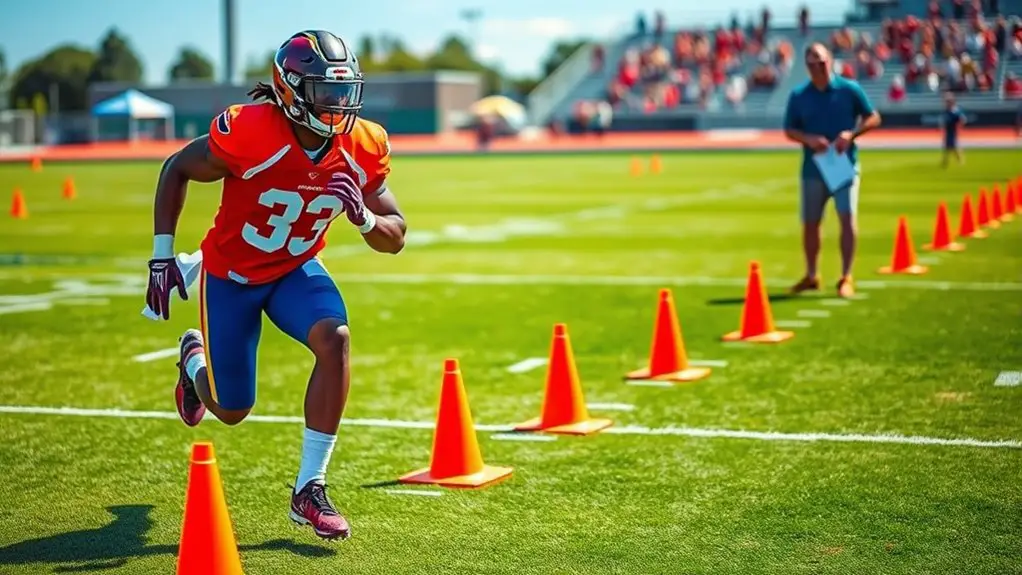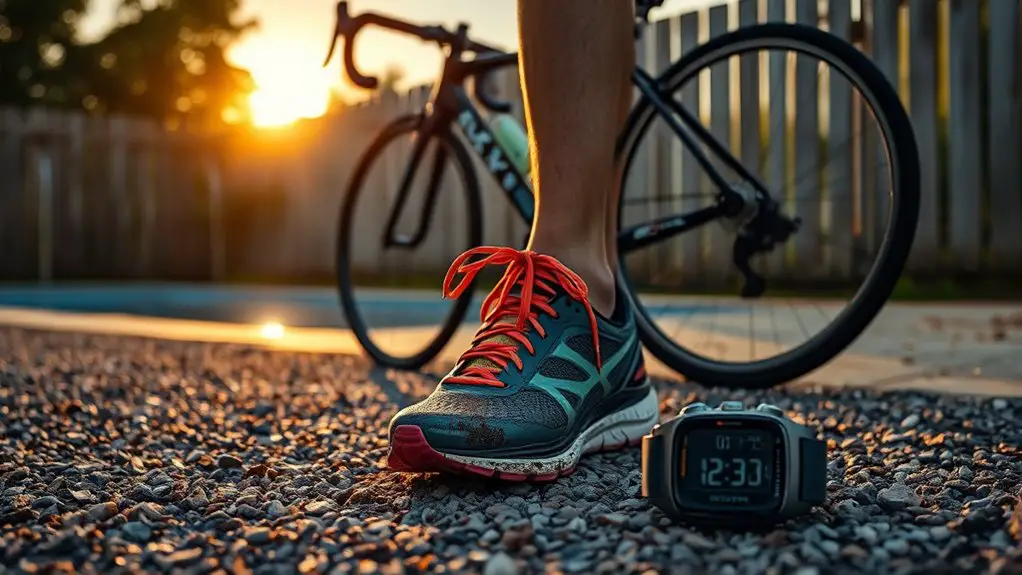To enhance your agility as a cornerback, focus on ladder drills for quick feet, cone drills for effective change of direction, and shuttle runs for acceleration and deceleration. The T-Drill helps with lateral movement, while reaction drills improve your anticipation on the field. Don't overlook one-on-one coverage drills for real-game scenarios. Incorporating plyometric exercises will also boost your explosive power. Keep exploring more techniques to elevate your performance on the gridiron.
Importance of Agility for Cornerbacks
Agility is essential for cornerbacks since it directly impacts their ability to respond to offensive plays. When you're on the field, those split-second decisions can make or break your cornerback performance. Being agile means you can shift your weight, change direction, and accelerate quickly, giving you the freedom to react to receivers' movements. The agility benefits extend beyond just speed; they enhance your overall game awareness, allowing you to anticipate the play better.
With improved agility, you'll find yourself more in sync with your teammates, closing gaps and covering ground effortlessly. This not only boosts your confidence but also elevates your entire defense. Embracing agility can free you from the constraints of slower movements, enabling you to express your skills fully. Therefore, incorporating strength and conditioning into your training regimen can significantly enhance your agility and performance on the field. So, focus on honing your agility to unleash your true potential as a cornerback and dominate the field.
Ladder Drills for Quick Feet
To enhance your agility on the field, ladder drills are a fantastic way to develop quick feet. These drills help refine your footwork techniques and improve your overall performance as a cornerback. By incorporating various ladder variations, you can keep your training fresh and exciting. Here are a few effective drills to get you started:
| Drill Name | Focus Area | Key Benefits |
|---|---|---|
| Single Foot Hops | Balance & Control | Increases stability |
| Lateral Shuffles | Lateral Movement | Enhances side-to-side speed |
| Icky Shuffle | Quick Steps | Boosts agility and rhythm |
| In & Out Steps | Quick Direction Change | Improves reaction time |
Incorporating these drills into your routine can significantly enhance your overall agility and coordination.
Cone Drills for Change of Direction
When it comes to honing your change of direction skills, cone drills are essential. The Zig-Zag Cone Drill and T-Drill Agility Exercise are two effective methods to sharpen your agility and quickness on the field. Let's break down how each drill can benefit your performance as a cornerback. Additionally, these drills are crucial for enhancing agility and coordination, allowing you to react swiftly to opposing players and maintain control during critical plays.
Zig-Zag Cone Drill
One of the most effective drills for enhancing change of direction skills is the Zig-Zag Cone Drill. This drill's all about mastering the zig zag technique, which helps you navigate your opponent with agility and precision. To set it up, place cones in a zig-zag pattern, spaced about five yards apart. Start at one end, sprint toward the first cone, and plant your outside foot to pivot sharply toward the next one. Focus on maintaining low hips and quick feet as you weave through the cones. The key is to keep your body balanced while changing direction rapidly. Incorporating this drill into your routine can greatly improve your ability to react during game situations, giving you the freedom to excel on the field.
T-Drill Agility Exercise
The T-Drill Agility Exercise is a fantastic way to sharpen your change of direction skills, especially for cornerbacks. This drill helps you develop quick footwork and enhances your ability to react swiftly. You'll set up three cones in a "T" shape, sprint to the center, and then backpedal while maintaining control.
T drill variations can include different starting positions or adding ball handling to simulate game scenarios. The t drill benefits are significant; it improves your lateral movement and accelerates your decision-making under pressure. By mastering this drill, you'll feel more confident and agile on the field, giving you the freedom to outmaneuver your opponents. It's all about harnessing that quickness for a competitive edge!
Shuttle Runs for Acceleration and Deceleration
Although cornerbacks rely heavily on their speed, mastering shuttle runs can greatly enhance both acceleration and deceleration skills on the field. This drill emphasizes the shuttle technique, allowing you to make quick directional changes while maintaining your momentum. By focusing on short bursts of speed, you'll develop the agility benefits that are essential for staying ahead of your opponents.
To perform a shuttle run, start at a designated point, sprint to a marker, touch it, and return to your starting point before hitting another marker. This drill mimics real game scenarios where you need to accelerate quickly, then decelerate to change direction effectively. Incorporating shuttle runs into your training will not only improve your footwork but also sharpen your overall agility, making you more versatile. Additionally, integrating plyometric exercises into your routine can further enhance your explosive movements and speed. So, embrace the freedom that comes with enhanced agility, and watch your performance on the field soar!
T-Drill for Lateral Movement
When you want to elevate your lateral movement skills, the T-Drill is an excellent choice for cornerbacks. This drill enhances your agility and responsiveness on the field, allowing you to adapt quickly to your opponent's moves. By incorporating T-Drill variations, you can target different aspects of your lateral movement, maximizing effectiveness.
Here's a quick overview of T-Drill variations and their benefits:
| Variation | Lateral Movement Benefits |
|---|---|
| Standard T-Drill | Basic agility and speed development |
| Cone T-Drill | Improves direction change ability |
| Single-leg T-Drill | Enhances balance and stability |
| Partner T-Drill | Encourages competitive edge |
| Weighted T-Drill | Builds strength and endurance |
In addition to these variations, cone drills are also effective for mastering change of direction, further enhancing your overall agility on the field.
Backpedal Drills for Defensive Readiness
When it comes to backpedal drills, mastering proper stance techniques is vital for your success on the field. You'll also want to focus on acceleration and deceleration to guarantee you can react swiftly to the play. Let's break down these essential components to enhance your defensive readiness.
Proper Stance Techniques
Mastering proper stance techniques is essential for cornerbacks, as it sets the foundation for effective backpedal drills and overall defensive readiness. You gotta focus on stance fundamentals, which means keeping your feet shoulder-width apart and knees slightly bent. This body positioning not only enhances balance but also allows for quick reactions. Make sure your weight's evenly distributed, so you can shift easily in any direction. Keep your back straight and head up, allowing you to keep an eye on the receiver. By practicing these techniques, you'll feel more confident and agile on the field. Remember, a solid stance translates to improved performance during backpedal drills, helping you stay one step ahead of the competition. Get ready to elevate your game!
Acceleration and Deceleration Drills
With a solid stance in place, it's time to focus on acceleration and deceleration drills, which are essential for cornerbacks looking to enhance their defensive readiness. These drills help you master acceleration techniques, allowing you to explode off the line and close gaps quickly. Practice short sprints, gradually increasing your speed while maintaining control.
Equally important are deceleration mechanics. Work on stopping quickly without losing balance or momentum. Incorporate backpedaling into your routine, focusing on quick shifts and sharp cuts. This will prepare you to react to receivers and adjust your positioning seamlessly. By perfecting these skills, you'll gain the freedom to move fluidly on the field, making you a formidable defender. Embrace the challenge and see your performance soar!
Reaction Drills for Improved Anticipation
Although cornerbacks rely on speed and agility, developing sharp reaction skills is equally essential for anticipating plays. You can't just wait for the action to unfold; you've got to be proactive. Focus on drills that enhance your reaction timing. For example, partner up and use a ball or a whistle to signal sudden movements. This drills your brain to quickly process information and respond accordingly.
Incorporate anticipation techniques by watching your opponent's body language and watching for clues that hint at their next move. Utilize cone drills where you must react to visual cues, shifting your weight and direction on a dime. The more you practice these reaction drills, the more instinctual your responses will become. Ultimately, sharpening your anticipation skills will elevate your game, giving you the freedom to make split-second decisions and dominate on the field. Additionally, incorporating mental training techniques can further refine your ability to react swiftly and accurately under pressure.
One-on-One Coverage Drills for Real-Game Scenarios
When it comes to one-on-one coverage, mastering the Mirror Technique Drill can be a game changer for you. This drill helps you stay glued to your opponent while maintaining balance and control. Additionally, the Hip Shift Drill will enhance your ability to quickly change direction, essential for responding to a wide receiver's moves during real-game scenarios. Incorporating acceleration drills can further improve your speed and agility on the field.
Mirror Technique Drill
The Mirror Technique Drill sharpens your ability to stay in sync with a receiver's movements, essential for effective one-on-one coverage. This drill enhances your footwork and agility, allowing you to mirror the receiver's actions fluidly.
Here's a quick overview of the mirror technique benefits and variations:
| Benefits | Variations |
|---|---|
| Improved foot speed | Partner vs. receiver simulation |
| Enhanced reaction time | Cones for directional changes |
| Better body control | Shadowing with different speeds |
| Increased confidence | Adding fakes and sudden stops |
Incorporating these variations into your training routine can elevate your game, giving you the freedom to adapt in real-game scenarios. Embrace the challenge, and you'll see the improvements!
Hip Transition Drill
After mastering the Mirror Technique Drill, it's time to focus on the Hip Shift Drill. This drill hones your hip flexibility and foot placement for real-game scenarios. Start by pairing up with a partner. One of you will act as the receiver, while the other plays cornerback. As the receiver makes a move, practice shifting your hips while maintaining balance. Keep your feet light and adjust your foot placement to stay in front of the receiver. The key is to react quickly while staying low and agile. This drill not only improves your shift speed but also enhances your ability to mirror an opponent's movements. Embrace the freedom of movement and watch your coverage skills soar!
Plyometric Exercises for Explosive Power
Incorporating plyometric exercises into your training routine can greatly enhance your explosive power, which is essential for cornerbacks. These exercises focus on quick, explosive movements that help improve your speed and agility on the field. Think of plyometric variations like box jumps, squat jumps, and plyo push-ups. They build explosive strength, allowing you to react faster and burst off the line when it counts.
Start with basic jumps and progress to more complex drills as you gain confidence. Consistency is key; aim for two to three sessions a week. This way, you'll develop the muscle fibers needed for explosive actions, giving you that edge over your opponents. Remember, it's not just about strength; it's about how quickly you can generate that power. Incorporating plyometric exercises into your training can significantly boost your overall athletic performance. So, embrace these plyometric exercises, and watch your performance soar as you dominate the field!
Incorporating Agility Drills Into Your Training Routine
To enhance your performance as a cornerback, integrating agility drills into your training routine is essential. These drills offer significant agility benefits, improving your footwork, reaction time, and overall athleticism. To maximize effectiveness, aim for training consistency; consider incorporating these drills into your weekly schedule. Additionally, enhanced cardiovascular endurance from cross-training can further support your agility training, helping you maintain high performance throughout your workouts.
| Drill | Duration |
|---|---|
| Ladder Drills | 10 minutes |
| Cone Drills | 15 minutes |
| Shuttle Runs | 10 minutes |
| T-Drill | 15 minutes |
| 3-Cone Drill | 10 minutes |
Frequently Asked Questions
How Often Should Cornerbacks Practice Agility Drills?
Think of agility drills as the wind beneath your wings, lifting you to new heights. To soar, you should practice these drills 3 to 4 times a week. Frequency recommendations suggest mixing in drill variations to keep things fresh and exciting. Incorporating lateral movements and change of direction will enhance your skills, allowing you to embrace the freedom of the game. So, spread your wings and let your agility shine!
What Age Is Ideal to Start Agility Training for Cornerbacks?
It's best to start agility training during youth training, typically around ages 8 to 10. At this stage, kids are hitting important developmental milestones, making it the perfect time to introduce agility concepts. You'll find that incorporating fun drills can enhance their skills while keeping the process enjoyable. Emphasizing movement and coordination at a young age gives them the freedom to explore their athletic potential without pressure, setting a solid foundation for the future.
Can Agility Drills Prevent Injuries in Cornerbacks?
Agility drills can indeed play a significant role in injury prevention. By improving your coordination, balance, and strength, you're less likely to suffer from common injuries. The agility benefits extend beyond just performance; they help stabilize your movements, allowing for quicker reactions on the field. So, when you incorporate these drills into your training, you're not only enhancing your skills but also taking proactive steps to keep your body safe and healthy.
How Do Agility Drills Improve a Cornerback's Overall Performance?
"You can't teach an old dog new tricks." But when it comes to improving your performance, agility drills are essential. They sharpen your reaction time, letting you respond to plays with precision. By mastering footwork techniques, you'll enhance your ability to change direction quickly, making you less predictable. This freedom to move fluidly on the field not only boosts your confidence but also elevates your overall game, allowing you to outmaneuver opponents effortlessly.
What Equipment Is Recommended for Agility Training at Home?
When it comes to agility training at home, consider investing in agility cones and resistance bands. Agility cones help you set up various drills, allowing you to work on quick changes in direction. Resistance bands can add extra resistance to your movements, enhancing your strength and agility. Both tools are versatile, giving you the freedom to create your own workout routine tailored to your needs. You'll see improvements in no time!




